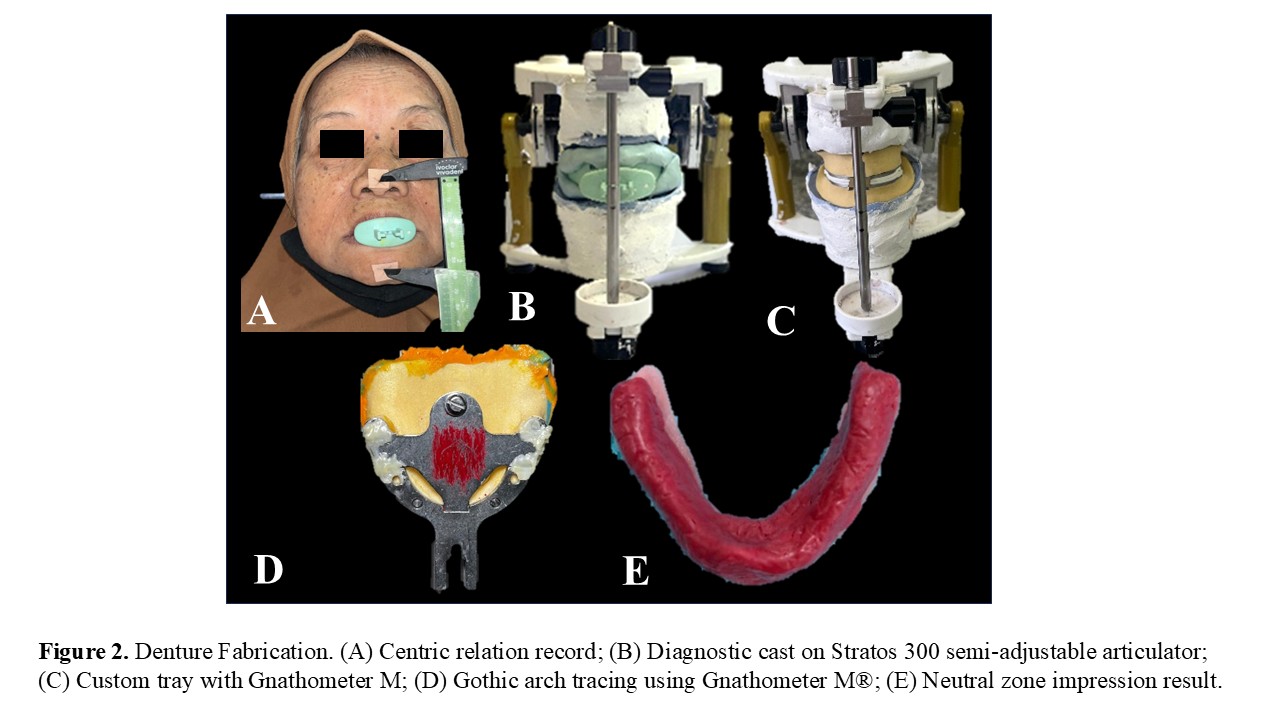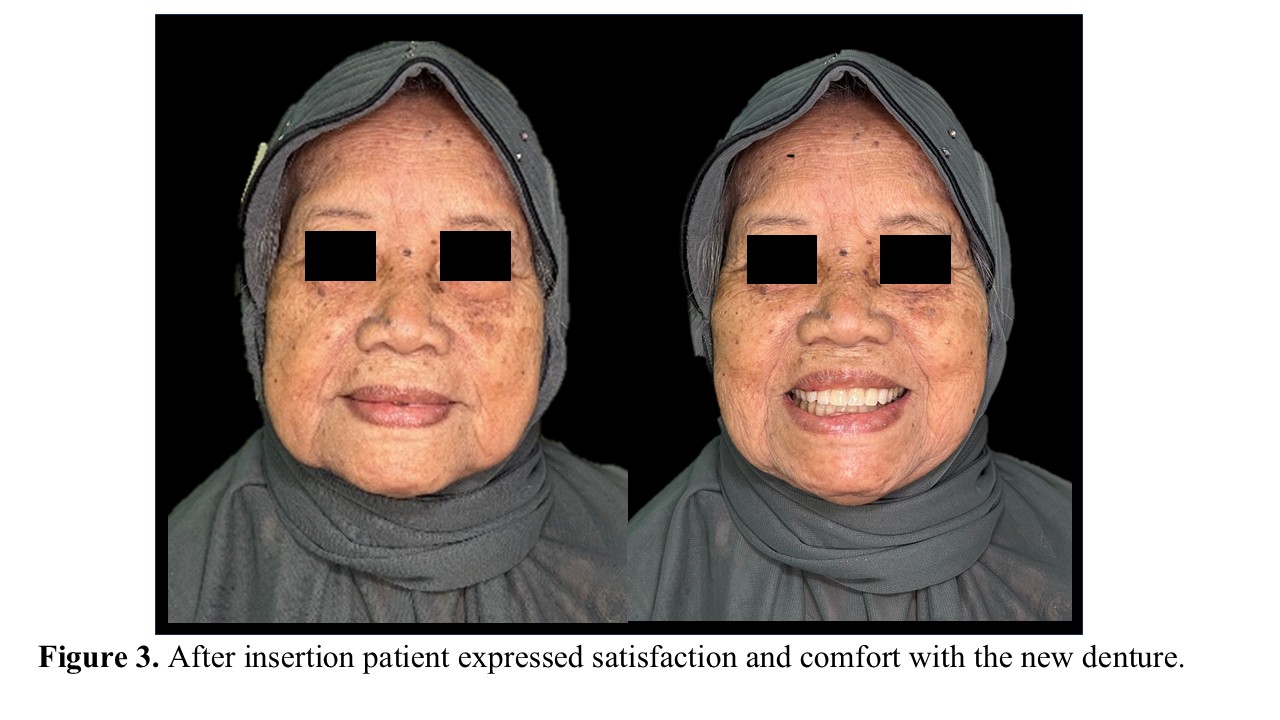Complete Denture Management in Complex Edentulous Case with PDI Class IV
Merina Dwi Pangastuti, Ratri Maya Sitalaksmi*, Nurani Atikasari and Nike Hendrijantini
Department of Prosthodontics, Faculty of Dental Medicine, Universitas Airlangga, Surabaya, Indonesia
Received Date: 09/05/2025; Published Date: 18/06/2025
*Corresponding author: Ratri Maya Sitalaksmi, Department of Prosthodontics, Faculty of Dental Medicine, Universitas Airlangga, Surabaya, Indonesia
Abstract
Edentulism, particularly in complex cases with severe alveolar ridge resorption, poor ridge morphology, and unfavorable muscle attachments, presents significant challenges in achieving functional and stable complete dentures. This case report presents a comprehensive prosthodontic rehabilitation of a completely edentulous patient with a Prosthodontic Diagnostic Index (PDI) Class IV classification, without surgical approach. An 80-year-old edentulous female patient presented to the Department of Prosthodontics, Universitas Airlangga Dental Hospital, requesting new complete dentures to replace her fractured previous set. Clinical and radiographic examinations revealed a severely resorbed alveolar ridge, poor ridge morphology, and unfavorable muscle attachments consistent with PDI Class IV. As the patient declined pre-prosthetic surgical procedures, a non-invasive treatment plan was implemented, utilizing a suction-effective mandibular denture technique in conjunction with neutral zone recording. The outcome demonstrated satisfactory denture retention, stability, and esthetics, underscoring the potential of prosthodontic solutions designed for complex edentulous cases without surgical intervention.
Keywords: Complete denture; Mandibular flat ridge; PDI Class IV; Suction-effective denture; Neutral zone
Introduction
Edentulism in patients with severe anatomical limitations presents a major challenge in prosthodontic rehabilitation. According to the Prosthodontic Diagnostic Index (PDI), Class IV represents the most complex cases, characterized by advanced ridge resorption, unfavorable morphology, and compromised muscle attachments [1,2]. These factors significantly affect denture fit, function, and overall comfort [3].
Although pre-prosthetic surgery is often considered to improve ridge conditions and support denture retention, many patients are not ideal candidates due to systemic health concerns, psychological factors, or financial limitations [4]. In such situations, non-surgical strategies become essential.
Convensional complete dentures depend largely on anatomical support and mechanical retention, which may be insufficient in severely resorbed ridges, leading to reduced stability and patient dissatisfaction [5]. A promising non-invasive solution is the suction-effective mandibular denture technique, introduced by Dr. Jiro Abe. This method incorporates functional impressions, detailed border molding, and optimal extension to create a peripheral seal, producing negative pressure that improves retention through suction [6,7].
Additionally, the neutral zone technique enhances denture stability by recording the oral space where muscular forces are in balance. Positioning the denture within this dynamic zone aligns it with the patient’s neuromuscular activity, significantly improving adaptation in compromised ridges [8,9]. Combining the suction-effective approach with the neutral zone concept offers a highly effective, non-surgical alternative for managing advanced ridge resorption, supporting better prosthesis retention, function, and comfort.
Case Report
An 80-year-old female patient with 30 years of edentulism visited the Prosthodontic Department at Universitas Airlangga Dental Hospital, requesting new dentures after her previous set fractured. She had controlled hypertension and no systemic contraindications.
Clinical examination revealed severe ridge resorption, particularly in the mandible, with poor ridge form and muscle attachments (Figure 1). Panoramic radiography showed total edentulism and a retained root at region 23 (Figure 2). The case was classified as PDI Class IV. Due to anatomical limitations and the patient’s refusal of surgery, complete dentures were planned using a suction-effective technique and the neutral zone approach for mandibular stability.
Preliminary impressions used hydrocolloid (Cavex Cream®) with AccuDent® and FCB trays. OVD was determined using anatomical landmarks, and centric relation recorded with a Centric Tray (Figure 3A). Casts were mounted on a Stratos 300 articulator (Figure 3B), and a tray with Gnathometer M® was prepared for final impressions (Figure 3C).
Definitive impressions used DMG materials with functional movements like “woo,” “eeee,” and swallowing to enhance peripheral seal. Centric relation was recorded with O-Bite, followed by facebow transfer and shade selection. Gothic arch tracing was done.
The neutral zone was recorded using a minimal-flange baseplate and functional compound molding through dynamic muscle activity. The index guided wax rim contouring and tooth placement.
Trial dentures were arranged in lingualized occlusion and evaluated for fit, aesthetics, and phonetics before final processing. After insertion and occlusal adjustment, follow-ups showed improved retention and function. A six-month recall was advised.



Discussion
Managing edentulous patients with PDI Class IV ridge resorption presents considerable clinical difficulties due to the severe loss of alveolar support and accompanying functional impairments [10]. In such scenarios, conventional dentures often underperform, as their retention depends heavily on the residual ridge anatomy. This commonly results in diminished chewing ability, unclear speech, and overall patient dissatisfaction.
In this case, a conservative strategy was chosen, employing the suction-effective mandibular denture technique introduced by Dr. Jiro Abe. This method involves dynamic impression-taking to capture functional muscle movements, allowing for an optimal peripheral seal that facilitates negative intraoral pressure, thereby enhancing denture retention [7]. This technique proves especially beneficial in mandibular arches with narrow ridges, high muscle activity, or challenging tongue posture [11]. By guiding the borders of the denture through functional movement, the flange conforms closely to the oral musculature during daily functions, such as swallowing or speaking, eliminating the need for adhesives or implants [6].
Occlusion also plays a pivotal role in denture success, particularly in cases with compromised ridges. In this case, a lingualized occlusal scheme was used, which channels occlusal forces more centrally along the ridge, limits lateral stresses, and contributes to denture stability during function [12]. Furthermore, this occlusion style offers bilateral contact, enhancing comfort and reducing dislodgment during mandibular motion [13].
To further improve prosthesis function, the neutral zone technique was integrated. This method identifies the area of balance between tongue forces and the opposing pressures of lips and cheeks, allowing for precise tooth placement and flange extension within this zone [14]. In patients with resorbed ridges, this muscle-guided approach is essential, as it compensates for the loss of anatomical landmarks and enhances prosthesis control during speech and mastication [15].
By combining the suction-effective impression method, lingualized occlusion, and neutral zone principles, this case demonstrated a stable, adhesive-free mandibular denture with excellent functional outcomes. The patient reported marked improvement in comfort, speech, and chewing, with no evidence of sore spots or instability during follow-up, suggesting proper load distribution and favorable tissue response.
This case underscores how advanced yet non-invasive prosthodontic strategies can produce successful rehabilitations in patients with severe ridge resorption. It also highlights the importance of respecting oral dynamics and applying occlusal concepts that suit the biomechanical challenges of edentulous conditions. Nonetheless, more longitudinal research is needed to validate the long-term reliability of these techniques across larger patient cohorts.
Conclusion
This case highlights the effectiveness of a non-invasive prosthodontic approach combining the suction-effective mandibular denture technique, lingualized occlusion, and the neutral zone concept in managing severe ridge resorption (PDI Class IV). Emphasis on accurate impression procedures, balanced occlusion, and muscular coordination contributed to excellent retention, functional stability, and patient satisfaction, without relying on adhesives or surgical intervention. These results support the clinical relevance of a conservative, function-oriented strategy in complex edentulous cases.
Authors' Contributions:
- Merina Dwi Pangastuti (guarantor) contributed to the concept and design of the study, data acquisition, analysis and interpretation, manuscript drafting, and critical revision.
- Ratri Maya Sitalaksmi contributed to supervision, critical revision for important intellectual content, and final approval of the manuscript.
- Nurani Atikasari contributed to clinical data acquisition, case documentation, and literature review.
- Nike Hendrijantini contributed to supervision, critical revision for important intellectual content, and final approval of the manuscript.
Institutional Credit: This work is credited to the Department of Prosthodontics, Faculty of Dental Medicine, Universitas Airlangga, Surabaya, Indonesia.
Conflict of Interest: The authors declared that they have no conflict of interest.
Grant Information: The author(s) received no specific funding for this work.
Acknowledgement: The authors have no acknowledgements to declare.
References
- Mulinari-Santos G, Mulinari-Santos G, Oliveira LB, Ferreira MC, Consani RLX. Anatomical and surgical considerations for fixed implant-supported prostheses in edentulous elderly patients. MOJ Gerontol Geriatr, 2024; 9(1): 1-5.
- Patel J, Patel P, Shah D, Bhad K, Doshi P, Bhatt R. Screening and allotting completely edentulous patients using Prosthodontic Diagnostic Index: a clinical study. J Clin Diagn Res, 2020; 14(8): ZC01-ZC04.
- Ratri M, Sitalaksmi. Suction-effective denture: a case report. J Int Dent Med Res, 2023; 16(1): 294-298.
- Khan S, Khan S, Khan S, et al. Why do patients refuse pre-prosthetic procedures? A qualitative study in a private sector dental teaching institute. Pak Armed Forces Med J, 2022; 72(2): 456-460.
- Sharma LA, Yaparathna N, Cheruka N, Shao P, Abuzar M. Evaluating Post-Insertion Complications and Patient Satisfaction of Conventional Complete Dentures: A Retrospective Study. Oral, 2024; 4(3): 362-375.
- Kamble VD, Parkhedkar RD. Mandibular suction effective denture for severely resorbed ridges: a review. J Indian Prosthodont Soc, 2018; 18(4): 301-305.
- Abe J, Kokubo K, Sato K. 4 Steps from Start to Finish: Mandibular Suction-Effective Denture and BPS. Quintessence Publishing Co., Ltd,
- Gupta N, Bhasin A, Sharma N. The neutral zone approach: a better outcome for resorbed mandibular ridges – a case report. Int J Appl Dent Sci, 2020; 6(2): 350-352.
- Elfadil S, Al Khaldi N, AlRaee A. Complete denture fabrication using neutral zone technique: a case report. Eur J Mol Clin Med, 2023; 10(4).
- Zarb GA, Bolender CL, Eckert S, et al. Prosthodontic Treatment for Edentulous Patients: Complete Dentures and Implant-Supported Prostheses. 13th ed. Mosby, 2012.
- Sato Y, Abe J, Ichikawa T. Application of the suction-effective denture technique in edentulous patients with severe ridge resorption. Int J Prosthodont, 2016; 29(3): 287–289.
- Pound E. Esthetic dentures and their phonetic values. J Prosthet Dent, 1951; 1(1): 98–111.
- Clough HE, Knodle JM, Leeper SH. Lingualized occlusion: a closer look. J Prosthet Dent, 1983; 50(5): 668–673.
- Limpuangthip N, Techapiroontong S, Prawatvatchara W. A systematic review of patient-oriented outcomes following complete denture treatment: a comparison between the neutral zone technique and conventional approach. BDJ Open, 2024; 10: 37.
- Ohkubo C, Hosoi T. Effect of the neutral zone technique on oral function and patient satisfaction in edentulous patients. Int J Prosthodont, 1999; 12(4): 343–348.

